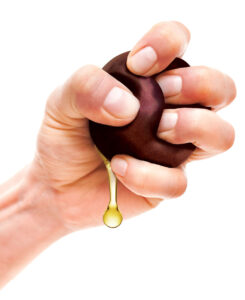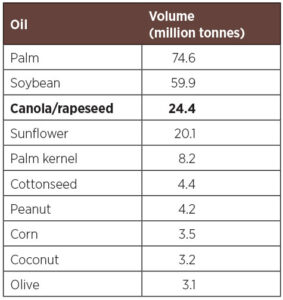Squeezing Oil From Seeds
 How do we get canola oil from canola seeds? Most companies that crush canola seeds in Canada also crush canola and many other oilseeds in processing facilities all around the world. These companies use the most efficient ways to process each crop to produce consumer-ready oils.
How do we get canola oil from canola seeds? Most companies that crush canola seeds in Canada also crush canola and many other oilseeds in processing facilities all around the world. These companies use the most efficient ways to process each crop to produce consumer-ready oils.
“Canola and rapeseed are considered ‘soft seeds’ and are actually processed the same way around the world.”
–Jeff Pleskach
“Canola and rapeseed are considered ‘soft seeds’ and are actually processed the same way around the world,” says Jeff Pleskach, trading director for Cargill’s Canadian crush business, which has facilities in Clavet, Saskatchewan, Camrose, Alberta and just broke ground for a new facility at Regina, Saskatchewan.
Canola is a brassica crop, mostly Brassica napus species, which Canadian breeders, through standard techniques in the 1970s, developed with low erucic acid and low gluconsinates. This improved crop was called canola. The U.S. and Australia also grow canola. Other countries, including France, Germany and the U.K., grow basically the same double-low Brassica napus crop, but in English, the name is oilseed rapeseed. The Food and Agriculture Organization of the United Nations, in its statistical analysis, combines all of these crops under the rapeseed name. Whether canola or rapeseed, processors cook and flake the seeds to prepare them for oil extraction, which is a two-step process. First is mechanical pressing, using screw presses to squeeze out about 80 per cent of the oil. Second is solvent extraction, which washes remaining oil from the “cake.” The cake or meal left over after the two extraction processes contains less than two per cent oil. (The article on page 22 describes all steps in more detail.)
Some specialized processors will use a second pass through mechanical processing instead of the solvent extraction, and some also skip the heating step. This canola oil has a stronger colour and taste, more like extra virgin olive oil, and is suitable for salad dressing and other limited uses where stronger flavour is the goal.
Amit Bhatt, plant manager at Louis Dreyfus Company’s (LDC) canola processing facility at Yorkton, Saskatchewan, started his career in India and says Indian mustard, a brassica plant similar to canola, is also processed using a slow mechanical-only method.
Bhatt worked with Adani Wilmar, a major Indian oilseed processor of various vegetable oil crops, before joining LDC in 2008. He worked at LDC’s facility in India where they refined and packaged soybean and palm oil, then a palm oil processing facility in Indonesia before moving to Canada in 2017 to process canola.
Palm is “very different” from canola, Bhatt says. Palm trees produce clusters of high-oil fruits, which are red-orange and about the size of a plum tomato. They are harvested on a regular basis throughout the year and go straight to processing. “Processing happens within a few hours of harvest, otherwise quality goes down,” he says.
Oil extraction from palm fruits is a one-step process: Add heat, then mechanical pressing.
“Because fruit from the palm tree has the highest-yielding fat content, the oil is extracted using only mechanical pressing,” Pleskach says.
Ninety to 95 per cent of palm comes from Indonesia and Malaysia, and those countries produce a lot of oil: Palm is the number one vegetable oil in the world in terms of volume. Soybeans are second. Soybean oil extraction is also only a one-step process, but in this case the step is solvent extraction. Soybeans are cleaned, de-hulled then heated and flaked to prepare for oil extraction.
“Soybeans are also processed the same way around the world,” Pleskach says. “Soybeans are first conditioned and then go through solvent extraction. There is no mechanical pre-pressing step.” The U.S., Brazil, Argentina and China are the main soybean-producing countries in the world.
Canola and rapeseed is the third most common vegetable oil produced. Fourth is sunflowers, a major oilseed crop of Ukraine and Russia and a few other European countries. North Dakota also grows oilseed sunflowers. “Sunflowers are the closest to canola in terms of processing,” Bhatt says. Shells are removed then seeds go through the two-step process of mechanical and solvent extraction.
“Sunflower processing happens the same way regardless of where it is grown,” Pleskach says.
Two differences between sunflower and canola processing are removal of the shells before flaking and removal of wax from the oil. Canola seed coats remain on through processing and become part of the meal which, like meal from most oil processing, is sold as livestock feed. With hull removal, sunflower meal has lower fibre and higher protein content, on a percentage basis, than canola meal.
Sunflower seeds have a waxy coating, and this wax is removed in the refining steps that follow extraction. One removal method is to gradually cool the oil to crystallize the wax, then filter the wax from the oil. Canola oil also goes through refining steps after oil extraction to remove gums, free fatty acids and fine meal particles, and to produce a clear oil with mild flavour.
The world processes many other vegetable oils, including olive oil. (See the top 10 oils by volume.) Olive oil has a wide range of grades, from extra virgin to pomace oil. The International Olive Council, based in Spain, the largest olive oil producing country, has detailed standards for processing and quality. Virgin olive oils are extracted using mechanical means only. After mechanical extraction the olive meal, or pomace, goes through solvent extraction to remove the remaining oil. Olive oil removed through this method must be labeled “olive pomace oil.” Blends of olive pomace oil and virgin olive oil are available in some supermarkets.
Volumes for top 10 vegetable oils
FAOSTAT, the agriculture statistics service of the Food and Agriculture Organization of the United Nations, tracks vegetable oil production around the world. Here are global production totals for 2019, the latest year for which olive oil stats are available.





